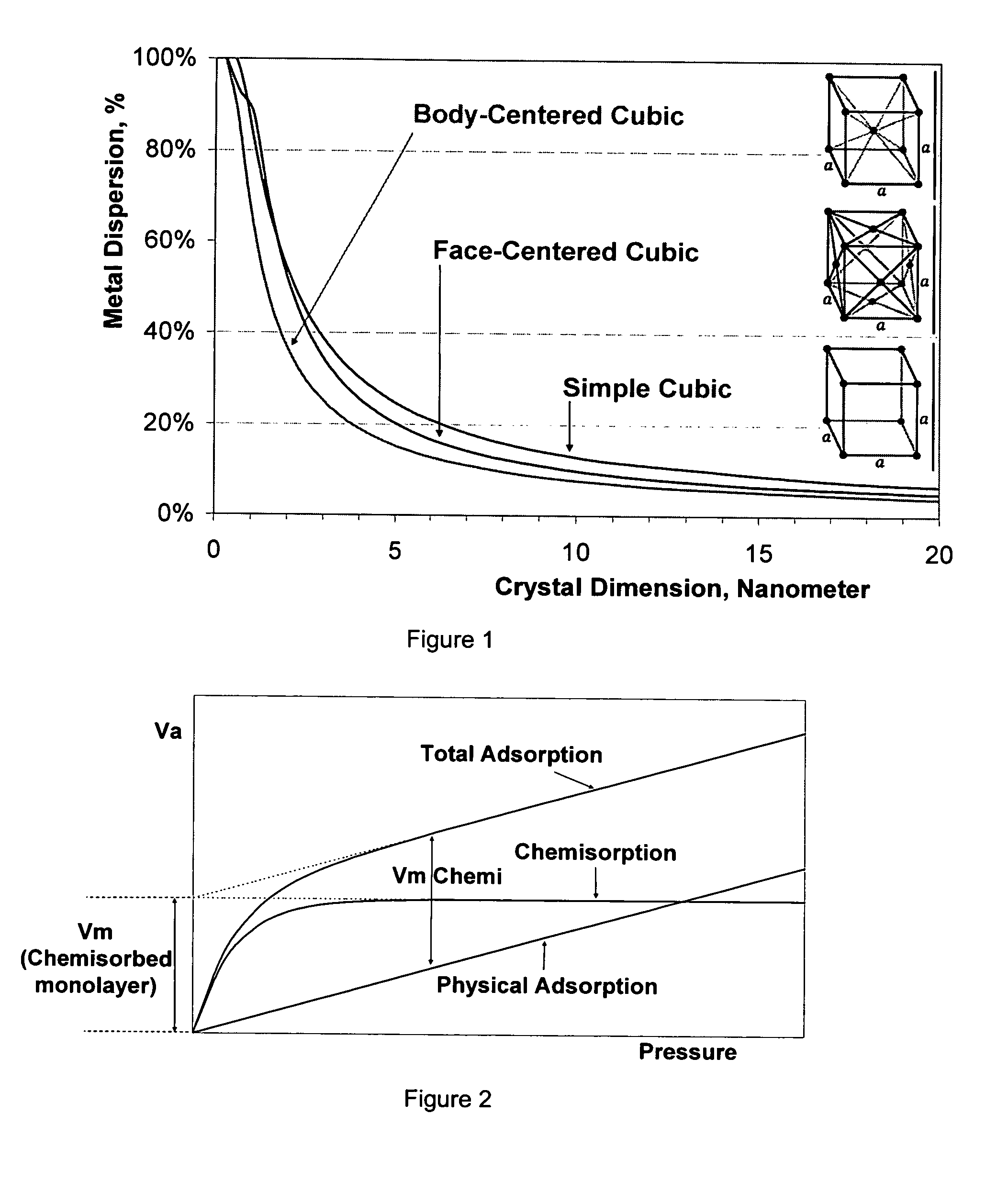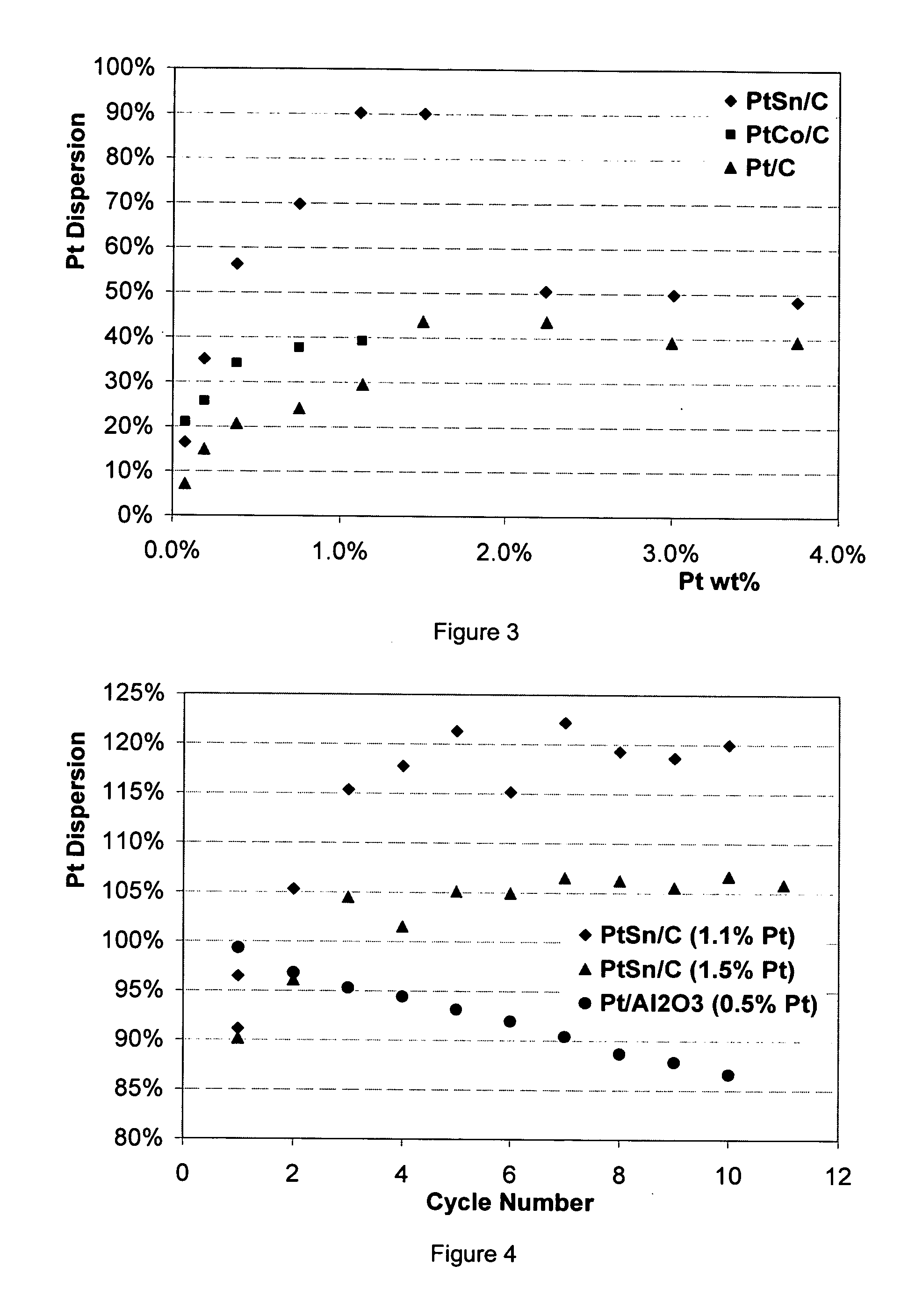Highly dispersed metal catalyst
- Summary
- Abstract
- Description
- Claims
- Application Information
AI Technical Summary
Benefits of technology
Problems solved by technology
Method used
Image
Examples
example 1
[0032]A Darco activated carbon from Aldrich (surface area, 681 m2 / g) is dried overnight to 110° C. to remove adsorbed moisture. A 1.0 gram sample of the dried activated carbon is used to determine void volume by filling with dionized water. A void volume was calculated as 1.83 milliliters / grams. A 40.0 aqueous solution containing 1.4681 grams of H2PtCl6.6H2O and 0.6335 grams of SnCl2.2H2O was prepared with HCl acid being added as needed to dissolve the salts. 5.5 milliliters of the dissolved salt solution was diluted with de-ionized water to 13.7 milliters. The diluted 13.7 mililiter solution was added to 5.0012 grams of the dried activated carbon. The activated carbon in the excess solution is removed by vacuum filtration. The solution uptake is recorded at 8.9 milliliters. The activated carbon is stirred and allowed to dry at least overnight at ambient conditions. It was found that drying must be very slow in order to maintain uniform dispersion of the desired metals within the ac...
example 2
[0034]The stability of the catalyst is also determined by cycling the resulting supported catalyst between ambient conditions and temperatures of 500-700° C. Following the cycles, and as set forth in FIG. 4, the catalyst activity actually increased following several cycles and stabilized at about 120% dispersion for the 1.1% Pt catalyst sample and about 106% dispersion for the 1.5% Pt catalyst sample evaluated. For comparison, the Pt dispersion of Pt / Al2O3 catalyst decreased moderately from 99.3 to 86.6% after 10 cycles.
example 3
[0035]Dispersion higher than 100% is known as a spillover effect. The spillover effect is a known phenomenon where adsorbed single H or O atoms exist at high mobility states moving from a Pt site to the activated carbon surface. It has been reported that spillover hydrogen can migrate as far as 5 mm on catalyst support.
[0036]As set forth in Table 1, data from chemisorptions using oxygen and hydrogen on two catalysts of Pt / Al2O3 and Pt / Sn / C is set forth. The data reported is chemisorption uptake relative to the catalyst Pt content at molar ratio and the Pt dispersion is based on H2-O2 titration methods. Results indicated no oxygen spillover on the Pt / Al2O3 catalyst since the Pt dispersion and O2 chemisorption uptake were essentially the same, while the H2 chemisorption was weak. In comparison, the oxygen spillover on the Pt / Sn / C was significant. The O2 chemisorption uptake was 235.1% of the total Pt, indicating significant amounts of oxygen atoms were spilled over to the carbon surfa...
PUM
| Property | Measurement | Unit |
|---|---|---|
| Temperature | aaaaa | aaaaa |
| Fraction | aaaaa | aaaaa |
| Angle | aaaaa | aaaaa |
Abstract
Description
Claims
Application Information
 Login to View More
Login to View More - R&D
- Intellectual Property
- Life Sciences
- Materials
- Tech Scout
- Unparalleled Data Quality
- Higher Quality Content
- 60% Fewer Hallucinations
Browse by: Latest US Patents, China's latest patents, Technical Efficacy Thesaurus, Application Domain, Technology Topic, Popular Technical Reports.
© 2025 PatSnap. All rights reserved.Legal|Privacy policy|Modern Slavery Act Transparency Statement|Sitemap|About US| Contact US: help@patsnap.com



